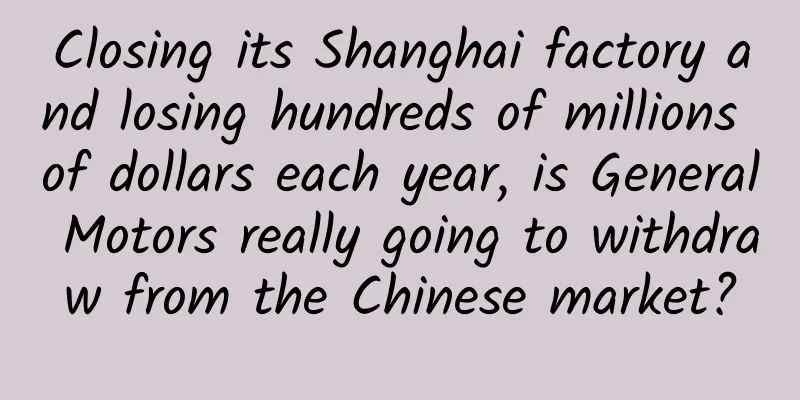Closing its Shanghai factory and losing hundreds of millions of dollars each year, is General Motors really going to withdraw from the Chinese market?

|
The Chinese auto market in the past two years has been like a "gold rush". Whether it is a joint venture or a domestically produced car, the fittest will survive and the weakest will be eliminated, and even General Motors, which has a century-old history, is no exception. Recently, a document submitted by General Motors to the U.S. Securities and Exchange Commission (SEC) showed that the company plans to incur asset impairment and restructuring costs totaling more than $5 billion. According to the content of the document, the US$5 billion consists of two parts: one part is the non-temporary impairment of US$2.6 billion to US$2.9 billion in the value of its Chinese joint venture in the fourth quarter of 2024; the other part is US$2.7 billion in SAIC-GM restructuring-related expenses, which will be used to close the joint venture factory with SAIC Group and plan to reduce the production of a number of unprofitable models. GM said the expense will be included in the company's fourth-quarter financial report and will not affect earnings before interest and taxes. In short, the $5 billion is not an investment expense, but a reduction in equity value due to a decline in investment income. Regarding the restructuring plan, GM China publicly stated that it is "taking measures to reduce inventory, produce on demand, protect the price system and reduce fixed costs." Just two days ago, General Motors (GM) announced that due to the high time and cost required to expand the business scale and increasingly fierce competition, after nearly a decade and more than $10 billion in research and development, it will stop financially supporting the Cruise self-driving taxi project and shift its research and development focus to self-driving technology for personal cars. Warren Buffett, the stock god, once said that General Motors (GM) is actually an annuity insurance company. The reason behind this is that the benefits GM provides to its employees are like a "lifetime pension insurance", which is almost the highest in the global automotive industry. And now this "charitable" company has even begun to strategically shrink by reducing its business and laying off employees, which shows that the situation has become very urgent. General Motors' performance in the Chinese market in the past two years has also seemed to be struggling, and we can see this intuitively from its sales performance. Relevant information shows that in the first three quarters of this year, GM suffered losses in China, with a loss of $137 million in the third quarter, compared with a profit of $192 million in the same period last year. In 2017, the company made a profit of $2 billion in China. How big is the gap? There is no need to explain it clearly, right? As Whiston said, GM's days of making $2 billion a year in China "are over, and probably forever." Regarding this situation, GM Chief Financial Officer Paul Jacobson said at the UBS Global Industrial and Transportation Conference that GM does not plan to inject more funds from the United States into China. GM's goal is to restore profitability in China in 2025, but the scale will be reduced. Although this statement is euphemistic, it also indirectly expresses GM's attitude towards the Chinese market. Not injecting more funds, only reducing the scale, and finally restoring profitability, this feels "self-contradictory" no matter how you look at it. After all, success in today's Chinese auto market cannot be determined by simply reducing scale, unless GM has no intention of staying in the Chinese market for long. GM and SAIC have cooperated for many years, and in the era of fuel vehicles, this cooperation has always been a win-win situation. However, after the gradual prevalence of new energy, such cooperation seems to have been unable to keep up with expectations. From 2019 to 2023, SAIC-GM's annual sales volume dropped from more than 1.6 million vehicles to 1.001 million vehicles, a drop of about 37%. Since the beginning of this year, the rate of decline has been visibly accelerating. SAIC Group's November production and sales report showed that SAIC-GM's terminal sales volume was 56,000 vehicles, a year-on-year decrease of 35.36%. From January to November, the cumulative terminal sales volume was only 370,000 vehicles, a year-on-year decrease of 58.61%. The sales volume has dropped sharply and the losses of enterprises have increased, which will seriously hit the confidence of both parties in cooperation. Netizens have different opinions on why this situation has occurred. Some industry insiders said that American cars have been unpopular in China in recent years. Chinese people now like to buy cars with large space and fuel efficiency. The characteristics of American cars are not suitable for the Chinese market. In addition, many joint ventures did not take a positive attitude towards the development of new energy vehicles in the past few years, which led to SAIC-GM's new energy vehicles making slow breakthroughs in the domestic market. Even though it has awakened in the past two years, it is still difficult to catch up with those new forces. A variety of reasons have led to a gradual decline in GM's share of the Chinese auto market. Even since 2015, things have been going wrong. Its market share in China has plummeted from about 15% in 2015 to 8.6% last year. According to regulatory documents, GM's profits in China are also declining, down 78.5% since its peak in 2014. Although Mary, GM's vice president of global manufacturing engineering, vice president of global human resources, and executive vice president of global product development, purchasing and supply chain, said that GM will launch new products to better participate in market competition, such as pure electric vehicles and plug-in hybrid electric vehicles. However, the new energy landscape of China’s current automobile market is in the process of being finalized, and it is very difficult to “break through” in the competition for new energy vehicles in China through automobiles. A series of factors such as declining sales, reduced production capacity, and GM's move to write down the value of its business in China have led many people to believe that GM is likely to "sell its brands, terminate joint ventures, and withdraw from the Chinese market." Although GM flatly denied this and said that its Chinese business is a high-quality asset for our present and future, its cooperation and exchanges with its joint venture partner SAIC Group will be closer than ever before to achieve profitability and sustainable development. But behind the official statement is the reality that GM wants to write down the book value of its assets to recoverable amounts, avoid investing more money in the joint venture, and let the joint venture "take its course." Now, the joint venture agreement between Volkswagen and SAIC has been renewed six years ahead of schedule in November this year, while the joint venture contract between GM and SAIC is about to expire in 2027. At present, apart from the rumors of value reduction, there seems to be no other movement. So, do you think that the joint venture contract between GM and SAIC will continue, and will GM use this opportunity to withdraw from the Chinese market? As a winner of Toutiao's Qingyun Plan and Baijiahao's Bai+ Plan, the 2019 Baidu Digital Author of the Year, the Baijiahao's Most Popular Author in the Technology Field, the 2019 Sogou Technology and Culture Author, and the 2021 Baijiahao Quarterly Influential Creator, he has won many awards, including the 2013 Sohu Best Industry Media Person, the 2015 China New Media Entrepreneurship Competition Beijing Third Place, the 2015 Guangmang Experience Award, the 2015 China New Media Entrepreneurship Competition Finals Third Place, and the 2018 Baidu Dynamic Annual Powerful Celebrity. |
<<: From iPhone 7 to Huawei P10, what is the secret behind the non-pressable Home button?
>>: The world's first Snapdragon 835 Win10 PC is launched: 8+128GB powerful configuration
Recommend
Long picture | The observation point is Lenghu
Qinghai, Lenghu, Saishiteng Mountain, the highest...
A million-follower celebrity complained that WeChat was difficult to use: videos and emoticons took up 100GB of C drive space
It's that time again when the general public ...
Marketing tricks for Children's Day topics!
Let’s talk about how to do topic marketing on Chi...
Analysis of Tik Tok Media Advertising in Q4 2019
The short video industry still has great potentia...
Why do wild geese fly in a line or a V-formation?
This article was reviewed by Zhu Guangsi, a popul...
Has online traffic really dried up?
In recent years, we heard that Ma Huateng , Jack ...
18 ways to monetize short videos
18 ways to monetize short videos The course is 60...
Analysis of the current status of the video material market and advertising strategies!
Everyone is familiar with advertisements. There a...
Mammoths have repeatedly appeared in permafrost. What warnings and impacts does this bring to humans?
According to media reports, several gold miners r...
APP promotion: How to acquire users through cold start?
Acquiring users is the beginning of achieving use...
These processes of Apple cannot be copied
[[123145]] "The last thing I want to say abo...
New Brand Marketing Model-Reflective Marketing Thinking
In marketing work, we often encounter the followi...
Six steps for Xiaohongshu UP masters to make money. Even novices can earn more than 5,000 yuan a month by mastering the methods
The core significance of the Xiaohongshu APP: Xia...
How was the Snake Battle that dominated the charts for over a week and went viral on WeChat Moments created?
The second hit product of 2016, Snake Wars, is he...
User operation customer acquisition and conversion methods!
Today I will introduce to you ARGO, a user operat...









